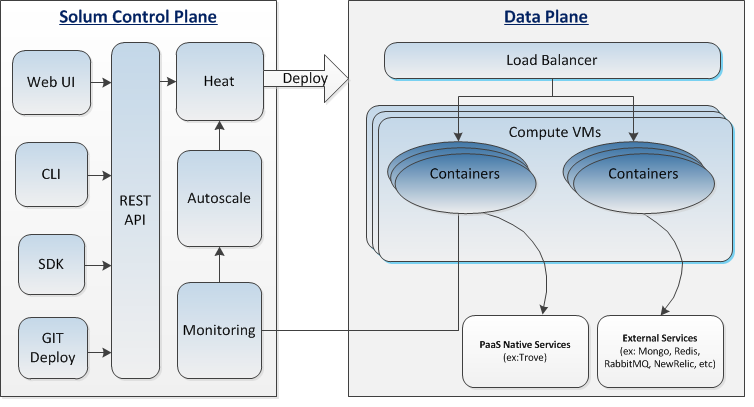Difference between revisions of "Solum/HighLevelRoadmap"
< Solum
(→Version 0.1: Basic app deployment functionality) |
(→Solum User Interface) |
||
| Line 4: | Line 4: | ||
==== Solum User Interface ==== | ==== Solum User Interface ==== | ||
| + | |||
Solum exposes its "user interface" via the following mechanisms: | Solum exposes its "user interface" via the following mechanisms: | ||
| + | |||
* REST API | * REST API | ||
| − | * CLI interface | + | ** Consumed by: |
| − | * GIT | + | *** CLI interface |
| − | * a set of SDK's in various languages | + | *** GIT |
| − | * UI Console | + | *** a set of SDK's in various languages |
| − | * IDE Plugins | + | *** UI Console |
| − | + | *** IDE Plugins | |
| − | |||
| − | |||
| − | |||
==Solum Roadmap== | ==Solum Roadmap== | ||
Revision as of 18:37, 11 October 2013
Contents
System Overview
Solum User Interface
Solum exposes its "user interface" via the following mechanisms:
- REST API
- Consumed by:
- CLI interface
- GIT
- a set of SDK's in various languages
- UI Console
- IDE Plugins
- Consumed by:
Solum Roadmap
Version 0.1: Basic app deployment functionality
- SOLUM-R1: Application deployment/management
- SOLUM-R2: Capability: Language pack framework along with automatic selection of packs [R2.1, R2.2]
- SOLUM-R3: Enable language ‘X’ via the language pack framework [Pick any of Java, Ruby, Python, Node.js, PHP]
- SOLUM-R4: CLI
- SOLUM-R5: User Authentication
Version 0.2: Additional features
- SOLUM-R6: Capability: Service Add-on framework
- SOLUM-R7: Enable Trove via the Add-on framework
- Streaming logs (not archive) – consolidated view of logs for a given app
- Language pack framework – combine packs, ability to pick a specific pack [R2.3, R2.4]
- Load balanced set of app container instances
- Additional languages and services [example services - MongoDB, MemCache, NewRelic, etc]
Version 1.0: Production ready
- Environments (Dev, Test, Prod, custom), application lifecycle management (promote code from dev to test to prod)
- Auto scaling
- Self-healing
- Application performance monitoring (CPU, memory utilization, etc.)
- Continuous Integration (e.g. Jenkins)
- SDK for interfacing with the PaaS REST API
- Interactive Web Console
- Roles and privileges
Version 2.0: Advanced features
- Non-web workloads (Background and scheduled jobs)
- HA via distributed placement of load balanced set of code container instances
- Network isolation - dedicated private network for applications
- IDE Plugins for Eclipse, IntelliJ, JBoss Studio, Komodo
- Integration with online IDE
- Online developer sandbox
- Additional services

